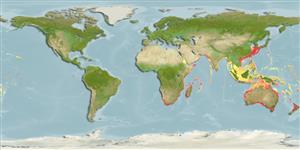Environment: milieu / climate zone / depth range / distribution range
Οικολογία
Θαλασσινό(ά); Υφάλμυρο βενθικό(ς); εύρος βάθους 1 - 200 m (Ref. 4316), usually 75 - 150 m (Ref. 33616). Subtropical; 34°N - 43°S, 15°E - 154°W
Indo-West Pacific: Delagoa Bay, Mozambique to the Cape, South Africa; common in Australia and New Zealand and reported from Japan and Korea. Also reported from Hong Kong (Ref. 12086).
Length at first maturity / Μέγεθος / Βάρος / Age
Maturity: Lm 21.2 range ? - ? cm
Max length : 60.0 cm TL αρσενικό/απροσδιόριστο; (Ref. 4316); common length : 40.0 cm TL αρσενικό/απροσδιόριστο; (Ref. 9258); μεγ. δημοσιευμένο βάρος: 1.5 kg (Ref. 9988); μεγ. αναφερόμενη ηλικία: 15 έτη (Ref. 9072)
Short description
Κλείδες προσδιορισμού | Μορφολογία | Μορφομετρία
Ραχιαίες άκανθες (συνολικά) : 9 - 10; Μαλακές ραχιαίες ακτίνες (συνολικά) : 15 - 16; Εδρικές άκανθες: 0; Μαλακές εδρικές ακτίνες: 14 - 16; Σπόνδυλοι: 33 - 35. Olive or brownish in color, becomes red when stressed; lower half of the inner part of pectoral fin with large black blotch surrounded by numerous pale spots (Ref. 9771).
Found from estuaries to edge of continental shelves over sand and sandy shell seabed (Ref. 9258). Reported to be often found in rivers (Ref. 4316). Juveniles may occur in bays (Ref. 33616). Benthic (Ref. 58302). Dorsal spine reported to be venomous (Ref. 9771). Neither anterolateral glandular grooves nor venom gland is present (Ref. 57406). Current information in the table (dangerous fish) do not match; needs verification. Excellent food fish (Ref. 9771). Utilized fresh and frozen; eaten pan-fried, broiled, microwaved and baked (Ref. 9988).
Heemstra, P.C., 1986. Triglidae. p. 486-488. In M.M. Smith and P.C. Heemstra (eds.) Smiths' sea fishes. Springer-Verlag, Berlin. (Ref. 4316)
IUCN Red List Status (Ref. 130435)
Human uses
αλιεία: Εμπορικό(ά)
Εργαλεία
Special reports
Download XML
Διαδικτυακές πηγές
Estimates based on models
Preferred temperature (Ref.
123201): 13.3 - 25, mean 19.3 °C (based on 186 cells).
Phylogenetic diversity index (Ref.
82804): PD
50 = 0.5010 [Uniqueness, from 0.5 = low to 2.0 = high].
Bayesian length-weight: a=0.00776 (0.00405 - 0.01487), b=3.07 (2.90 - 3.24), in cm total length, based on LWR estimates for this species & (Sub)family-body (Ref.
93245).
Τροφικό Επίπεδο (Ref.
69278): 3.7 ±0.57 se; based on food items.
Generation time: 2.7 (1.9 - 3.0) years. Estimated as median ln(3)/K based on 10
growth studies.
Ελαστικότητα (Ref.
120179): Μεσαίο(α), ελάχιστος χρόνος για διπλασιασμό πληθυσμού 1,4 - 4,4 έτη (K=0.4-0.6; tm=2-3; tmax=15;).
Prior r = 0.36, 95% CL = 0.24 - 0.55, Based on 1 data-limited stock assessment.
Fishing Vulnerability (Ref.
59153): Low to moderate vulnerability (29 of 100).
Climate Vulnerability (Ref.
125649): Moderate to high vulnerability (45 of 100).
Nutrients (Ref.
124155): Calcium = 88.2 [46.4, 215.9] mg/100g; Iron = 1.09 [0.59, 2.04] mg/100g; Protein = 19.3 [18.0, 20.7] %; Omega3 = 0.381 [0.173, 1.076] g/100g; Selenium = 41.3 [20.5, 90.6] μg/100g; VitaminA = 7.38 [2.92, 18.85] μg/100g; Zinc = 0.753 [0.531, 1.080] mg/100g (wet weight); based on
nutrient studies.
